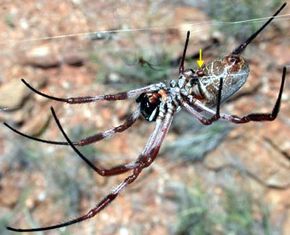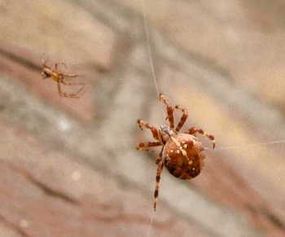Quck answer
Spiders are arachnids that have eight legs and two body segments. They are carnivorous and use their venom to immobilize their prey. Spiders have specialized structures called spinnerets that produce silk, which they use to build webs for catching prey, as well as for shelter and reproduction. Different spider species have different hunting strategies, such as stalking or ambushing their prey. Spiders are important predators in many ecosystems and play a crucial role in controlling insect populations. Some spider species are venomous and can be dangerous to humans, but most are harmless.
Wild Animals
Mating Struggles

Photo by Steve Clark
The main goal of the male spider is to mate with one or more female spiders before other males do. However, this is a challenging task in most spider species.
The first obstacle is locating a female spider. Since most spider species are solitary creatures that live and feed on their own, finding a receptive female can be difficult. The male spider has to search for a sexually mature female in the area before other males do.

Male and female spiders of the same species may appear entirely different. A small male golden orb spider (indicated by the yellow arrow) is seen climbing on a large female. Below are a female (green) and male (brown) of the crab spider species Micrommata virescens.
Photo by Ed Nieuwenhuys
In most spider species, the female secretes pheromones, communicative chemicals, which make it easier for males to locate them. Female ground spiders, for example, release pheromones onto their dragline, a silk thread they leave behind. When males of the same species come across the dragline, they detect the pheromone with the chemical sensors on their front legs and follow the trail to the female.
Web-spinning female spiders may release pheromones directly into the air or coat their webs with pheromones, creating a natural “chemical antenna.” Alternatively, males may wait for sexually immature female spiders to mature and be the first to mate after the spider’s final molt.
Once the male finds a female, it has to compete with other males in the area. In species where the female spins a pheromone-coated web, the male’s first job is to destroy the web to cut off the signal attracting any other males. If other males are present, the spiders will usually fight over the right to mate with the female.
After eliminating any other male competitors, the male spider must focus on courting the female spider. Since males are usually much smaller than females in their species, they are easy prey. The male needs to convince the female that it is a spider of the same species, rather than food or a potential predator, and that it wants to mate. This is known as courtship.

An Araneus diadematus male approaches a female.
Photo by Ed Nieuwenhuys
The courtship ritual differs significantly among various species. Many web-building spiders communicate their intentions through vibration. The male may strum a unique signal on a thread connected to the female’s web to identify itself and get its message across. Various wolf spiders and jumping spiders, which have better eyesight, “dance” to court the female.
Once the female recognizes the male’s courtship behavior, she will either position herself for sex, indicating that she is receptive, or make it clear that she is not receptive (such as by shaking her web or crawling away). If the male is desperate to mate because all the females in the area will soon lay their eggs, he may proceed regardless of the female’s response, knowing full well that she might kill him.
Spiders have their reproductive organs located at the rear of their abdomen. Both males and females deposit and receive sperm through a unique process. Males deposit sperm onto a small web, which they then pick up with their pedipalps. When the female is in position, the male deposits the sperm in the female’s genital opening. Females then store the sperm in receptacles near their ovaries and use it to fertilize their eggs when they are ready to lay them, which can be months later. Some spiders can lay hundreds or thousands of eggs at once. In the following section, we will explore what happens after the eggs are fertilized.
FAQ
1. What are the different types of spiders?
There are over 45,000 species of spiders, but they can generally be categorized into two main types: web-building spiders and hunting spiders. Web-building spiders use their silk to create intricate webs to catch their prey, while hunting spiders actively hunt their prey without the use of webs.
2. How do spiders create their webs?
Spiders produce silk from glands in their abdomen, which is then spun into webs using specialized organs called spinnerets. The silk is incredibly strong and can stretch up to five times its original length without breaking. Each species of spider creates a unique pattern of web, which can be used to identify the type of spider.
3. How do spiders catch their prey?
Web-building spiders catch their prey by waiting for insects to become trapped in their webs. Once an insect is caught, the spider will bite it to inject venom and then wrap it up in silk to immobilize it. Hunting spiders use their speed and agility to chase down their prey, and will also use venom to subdue it.
4. Can spiders be dangerous to humans?
While most spider bites are harmless to humans, there are some species of spider that can be dangerous. The black widow and brown recluse spiders are both venomous and can cause serious health problems if bitten. It is important to seek medical attention if you suspect you have been bitten by a venomous spider.
5. How do spiders reproduce?
Male spiders produce sperm, which is stored in specialized organs called pedipalps. When a male finds a female, he will transfer his sperm to her using his pedipalps. The female will then lay eggs, which she will protect until they hatch into spiderlings.
6. How do spiders molt?
As spiders grow, they must shed their exoskeletons in a process called molting. During molting, the spider will split its old exoskeleton and emerge with a new, larger one. Molting can be a dangerous time for spiders, as they are vulnerable to predators and may be unable to move or defend themselves while their new exoskeleton hardens.
7. How do spiders survive the winter?
Spiders have a number of adaptations that help them survive the cold winter months. Some species will lay eggs that will hatch in the spring, while others will overwinter as adults. Some spiders will also produce a chemical called glycerol, which acts as an antifreeze and allows them to survive in freezing temperatures.





Leave a Reply